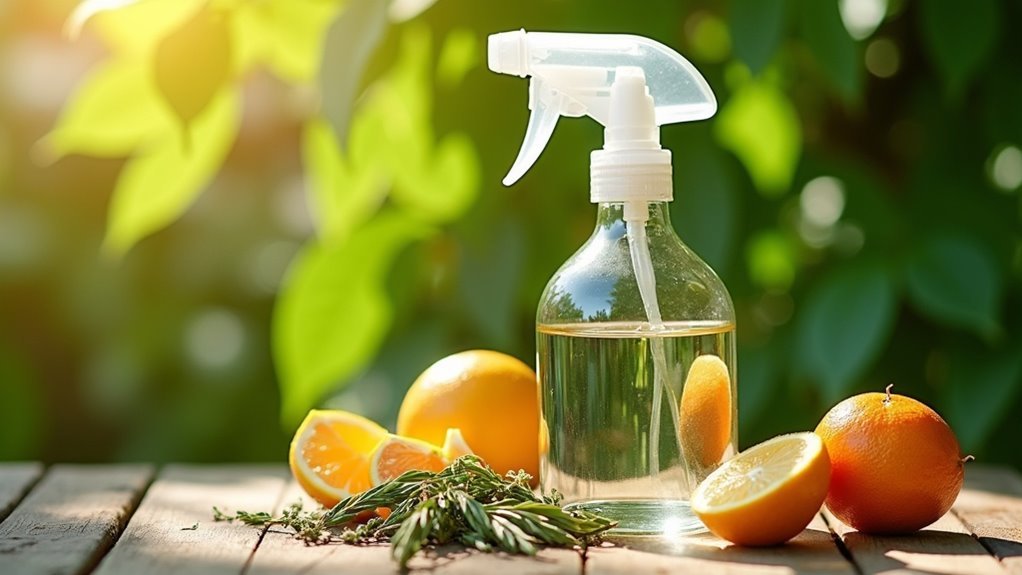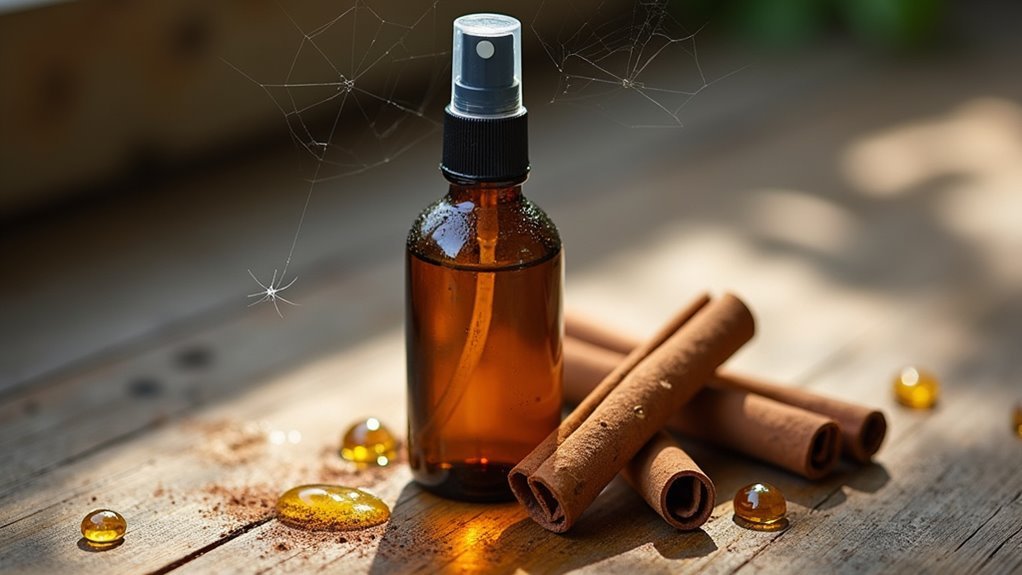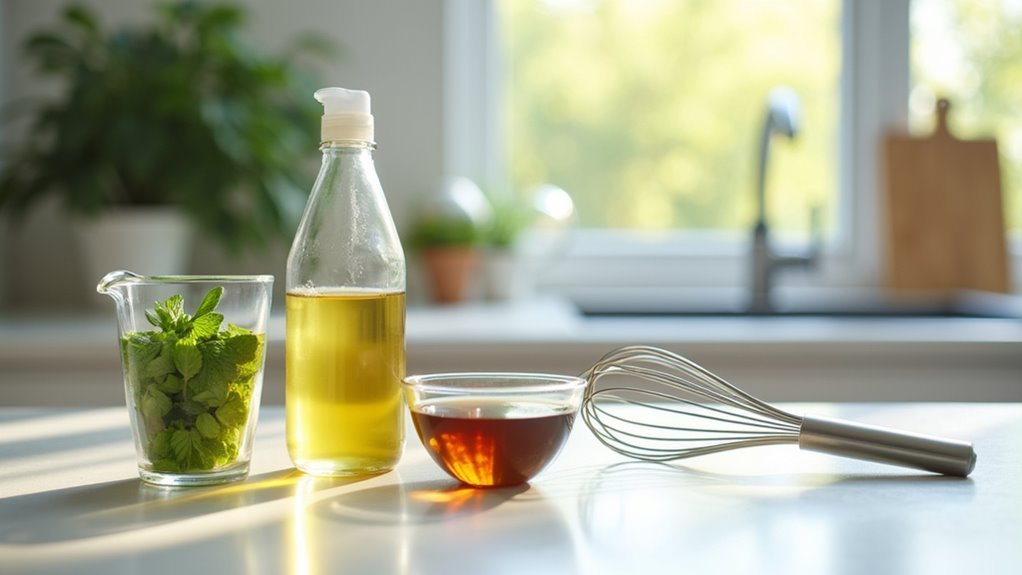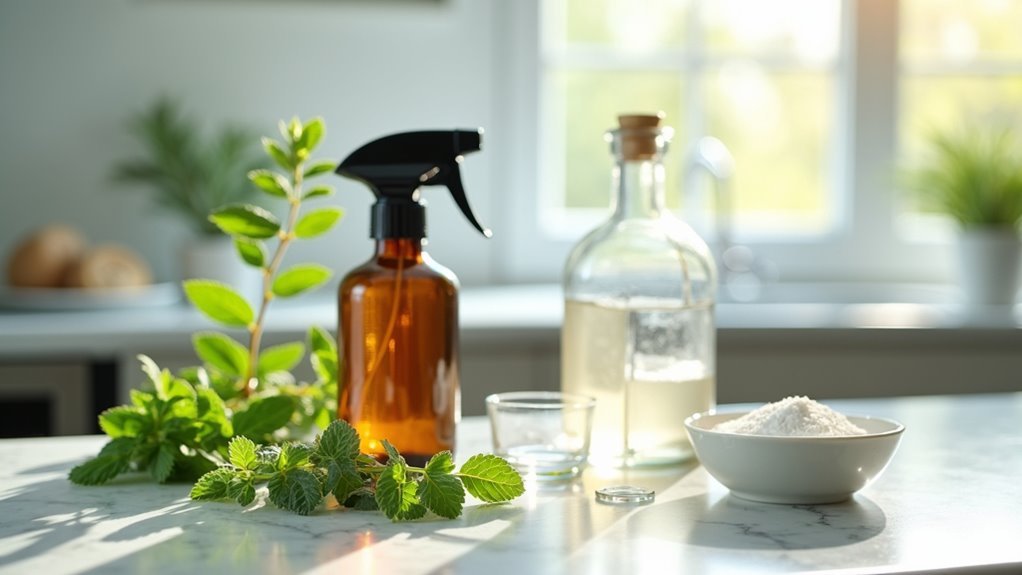You’ll get the best results with a cinnamon essential oil spray combining 2 cups distilled white vinegar, 1/4 cup liquid dish soap, and 30 drops cinnamon essential oil. Mix the soap first, add vinegar, then the oil, and shake vigorously for 20 seconds. Spray directly on spiders, webs, and hiding spots like shower corners and behind toilets. Reapply weekly for consistent effectiveness. This natural formula disrupts spiders’ sensory perception while remaining safe around family and pets, though proper application techniques can maximize your success.
Why Homemade Spider Sprays Work Better Than Store-Bought Options

While commercial spider sprays line store shelves with bold promises, homemade alternatives consistently outperform them in both effectiveness and safety.
You’ll find that natural spider repellent solutions using essential oils create potent scents that disrupt spiders’ sensory perception more effectively than many chemical alternatives. When you customize your DIY spray, you can target specific spider species and tailor the solution to your bathroom’s unique needs.
Your homemade nontoxic spider spray offers superior safety around children and pets, eliminating concerns about harsh chemicals in enclosed spaces.
You’ll also discover significant cost savings, as these solutions use common household items. While you’ll need to prevent spiders through frequent reapplication, this consistent approach often proves more effective than relying on single-application commercial products for long-term spider control.
Essential Ingredients for Effective Bathroom Spider Control
Success in bathroom spider control hinges on selecting the right combination of natural ingredients that work synergistically to repel and eliminate these unwanted visitors.
Your DIY spider spray requires three key components that deliver maximum effectiveness. Distilled white vinegar serves as your primary repellent, disrupting spider egg cycles while creating an inhospitable environment. The liquid soap acts as an adhesive agent, guaranteeing the solution clings to spiders for better contact killing. Essential oil and spray formulations become particularly potent when you add cinnamon oil, which functions as a natural insecticide.
| Ingredient | Amount | Primary Function |
|---|---|---|
| Distilled white vinegar | 2 cups | Repellent/egg cycle disruptor |
| Liquid soap | 1/4 cup | Adhesive agent |
| Cinnamon essential oil | 30 drops | Natural insecticide |
| Application frequency | Every few days | Population control |
| Safety rating | Nontoxic | Indoor use approved |
This nontoxic formula guarantees safe bathroom application around family members.
Cinnamon Essential Oil Spider Spray Recipe

Creating your own cinnamon essential oil spider spray takes just minutes and delivers powerful results against bathroom spiders.
You’ll need 2 cups of distilled white vinegar, 1/4 cup of liquid soap, and 30 drops of cinnamon essential oil in a 16-ounce glass spray bottle.
Start by adding the liquid soap first, then fill your bottle with vinegar. Add the cinnamon essential oil and shake vigorously for 20 seconds to combine everything properly.
This homemade spider spray is completely nontoxic and safe for indoor use, making it perfect for households with children and pets.
The vinegar and cinnamon combination effectively repel spiders while eliminating existing ones and their eggs when sprayed directly.
Regular application shows significant reductions in spider presence.
Peppermint Oil and Vinegar Combination Method
You’ll need specific ratios when mixing peppermint oil with vinegar to create an effective spider deterrent that works particularly well in bathroom environments.
The application technique matters just as much as the mixture itself, since you’re targeting areas where spiders commonly hide and enter your bathroom space.
This combination proves especially effective against certain spider species that frequent humid bathroom areas.
Mixing Ratios and Measurements
When mixing this natural spider deterrent, you’ll need exactly 2 cups of distilled white vinegar combined with 10-15 drops of peppermint essential oil in a 16-ounce glass spray bottle. These precise mixing ratios and measurements guarantee peak effectiveness for your spider repellent.
| Ingredient | Amount |
|---|---|
| Distilled white vinegar | 2 cups |
| Peppermint essential oil | 10-15 drops |
| Container | 16-ounce glass spray bottle |
The vinegar serves as your primary repelling agent, while the peppermint essential oil disrupts spiders’ sensory receptors. Don’t exceed the recommended oil amount, as too much can damage surfaces or create an overpowering scent. Always shake the mixture thoroughly before each application since essential oils naturally separate from vinegar over time.
Application Techniques for Bathrooms
After preparing your peppermint-vinegar solution, focus on targeting specific bathroom areas where spiders commonly establish their hideouts.
Apply the spray directly onto corners, behind toilets, around window frames, and beneath sinks where these pests typically lurk. Don’t forget baseboards and the spaces behind bathroom fixtures, as these dark spots attract spiders seeking shelter.
Shake your spray bottle vigorously before each application to guarantee the peppermint essential oil distributes evenly throughout the vinegar mixture.
Cover all target zones thoroughly, creating a barrier that’ll discourage spider activity. Reapply weekly or immediately after deep cleaning your bathroom to maintain effectiveness.
Always test on inconspicuous surfaces first, especially around delicate finishes or painted areas that might react to vinegar.
Effectiveness Against Spider Species
Understanding which spider species respond best to your peppermint-vinegar spray helps you gauge its real-world performance in your bathroom.
Most common household spiders, including house spiders and cellar spiders, show strong sensitivity to peppermint oil’s intense aroma. Since spiders have taste buds on their legs, the peppermint scent disrupts their sensory perception, making treated areas uncomfortable for them.
The vinegar component works double-duty by dissolving existing webs and creating an acidic environment that spiders avoid. This combination won’t deter spiders like black widows or brown recluses as effectively, but it’s highly successful against typical bathroom inhabitants.
Regular application prevents spider infestation in humid environments, making your spray particularly effective for moisture-loving species that frequent bathrooms.
Dish Soap Spider Elimination Technique
You’ll find dish soap creates an effective spider elimination solution when mixed properly with water.
The application method you choose directly impacts how well this technique works against spiders in your bathroom.
Before you start spraying, there are important safety steps you need to follow to protect yourself and others in your home.
Soap Solution Preparation Steps
Creating an effective soap solution requires just two simple ingredients and takes less than five minutes to prepare.
You’ll need approximately 2 cups of water and 1/4 cup of liquid dish soap in a spray bottle. This soap solution will kill spiders by coating their bodies and blocking their breathing passages.
Start by adding the water to your spray bottle first, then pour in the dish soap. If you prefer a lighter mixture, use water and 10-15 drops of soap instead.
Shake the bottle vigorously to guarantee the ingredients blend completely. The mixture should appear slightly cloudy when properly combined.
When applying, spray directly onto spiders and their webs, guaranteeing thorough coverage for maximum effectiveness.
Reapply weekly to maintain control.
Application Methods Effectiveness
When applying the dish soap solution effectively, direct targeting proves most successful for immediate spider elimination. Load your spray bottle with water and the dish soap mixture, then aim directly at visible spiders and their webs. This targeted approach guarantees the solution coats the spider’s body, disrupting their breathing mechanism and causing suffocation.
Different application methods vary in effectiveness. Spraying webs destroys spider habitats while direct contact eliminates spiders immediately. You’ll achieve better results by saturating the entire web structure rather than light misting.
For maximum impact, spray during evening hours when spiders are most active.
Reapply the effective spider control solution frequently in high-traffic areas. Consistent application prevents spider returns by maintaining an unfavorable environment they’ll avoid.
Safety Precautions Required
Although dish soap spider sprays appear harmless, proper safety precautions safeguard your family and home from unintended consequences. You’ll need to store solutions away from children and pets since ingestion causes adverse reactions. Test mixtures on inconspicuous surfaces before widespread indoor use to prevent staining.
| Safety Aspect | Required Action |
|---|---|
| Storage Location | Keep away from children and pets |
| Surface Testing | Test small inconspicuous areas first |
| Application Method | Direct spray onto spiders/webs only |
| Ventilation | Guarantee adequate airflow during indoor use |
| Professional Advice | Consult experts for severe infestations |
When applying sprays, you’ll target spiders directly rather than broad surface coverage. Multiple applications may be necessary for complete elimination, particularly with egg-bearing spiders. Seek professional advice if infestations persist despite repeated treatments.
Natural Essential Oil Blends That Repel Spiders
Since spiders rely heavily on their sensory perception to navigate and hunt for food, natural ingredients like peppermint, spearmint, citronella, cinnamon, and cloves disrupt their ability to function effectively in your bathroom.
These essential oils create powerful spider repellents that interfere with spiders’ taste buds located on their legs, making it difficult for them to locate food sources.
You can create an effective home improvement solution by mixing 5 drops of your chosen essential oil with dish soap and water.
This pleasant-smelling spray serves as a natural deterrent when applied regularly. For enhanced effectiveness, consider adding indoor plants like mint and thyme to your bathroom.
Reapply your essential oil spray weekly, especially during peak spider seasons, to maintain a consistent protective barrier against unwanted arachnid visitors.
Step-by-Step Mixing Instructions for Maximum Effectiveness

Now that you understand which oils work best against spiders, creating your homemade bathroom spider spray requires precise measurements and proper mixing techniques.
Start by combining 2 cups of distilled white vinegar with 1/4 cup of liquid soap in a 16-ounce glass spray bottle.
Begin your spider-repelling mixture by pouring distilled white vinegar and liquid soap into a clean glass spray bottle.
Add 30 drops of cinnamon essential oil to enhance the repelling properties.
Secure the spray nozzle tightly and shake vigorously for 20 seconds to guarantee all ingredients blend completely.
For maximum effectiveness, apply the solution generously to cobwebs, corners, and areas where spiders are likely to hide.
Reapply every few days and always store away from children and pets when not in use.
Application Techniques for Bathroom Surfaces
You’ll achieve the best results by focusing your spray on specific problem areas where spiders typically establish themselves in bathrooms.
Before treating the entire space, you should test your homemade solution on a small, hidden surface to verify it won’t cause staining or damage.
This targeted approach combined with proper surface testing will maximize your spray’s effectiveness while protecting your bathroom fixtures and finishes.
Target Problem Areas
When targeting problem areas in your bathroom, focus your spider spray application on the spots where these eight-legged intruders are most likely to establish their presence. Spiders tend to hide—under sinks, behind toilets, and within corners and crevices where moisture accumulates. You’ll want to spray in places spiders typically build webs, including window sills, door frames, and around plumbing fixtures.
| High-Risk Areas | Application Focus | Frequency |
|---|---|---|
| Shower corners | Direct spray on webs | Weekly |
| Under sink cabinets | Cracks and crevices | Weekly |
| Window sills | Entry point barriers | Bi-weekly |
| Behind toilet | Hidden spaces | Weekly |
| Bathtub edges | Moisture zones | Weekly |
If infestations persist, contact a pest control company for professional treatment.
Surface Testing Methods
Before spraying your entire bathroom, test your homemade spider solution on a hidden spot to avoid damaging delicate surfaces.
These surface testing methods protect your bathroom materials from potential staining or chemical reactions. Choose an inconspicuous area like behind the toilet or under a cabinet edge for your test patch.
Clean and dry the test surface thoroughly before applying a small amount of spider spray.
Wait 24 hours to check for discoloration, etching, or damage. If the surface remains unchanged, you’re ready for full application.
Once you’ve confirmed compatibility, verify all target areas are clean and dry before spraying.
This preparation step maximizes your solution’s effectiveness and delivers peak results against spider infestations throughout your bathroom.
Safety Considerations When Using DIY Spider Sprays
Why should safety be your top priority when creating homemade spider sprays? DIY solutions for household pests require careful handling to protect your family and property. Essential oil-based sprays, particularly those containing cinnamon, can cause skin irritation or reactions if misused.
| Safety Consideration | Action Required |
|---|---|
| Storage | Keep spray away from children and pets |
| Application | Apply when family members aren’t present |
| Testing | Perform patch test on inconspicuous areas first |
| Medical Concerns | Consult professionals about ingredient safety |
Always conduct a patch test before extensive application to prevent surface damage. Excessive use may create unwanted residue or overwhelming scents. Since natural ingredients don’t guarantee complete safety, follow recommended guidelines strictly and seek medical advice if you have concerns about reactions or ingredient sensitivity.
How Often to Reapply Natural Spider Repellent Mixtures
Since natural spider repellents break down faster than commercial chemicals, you’ll need to establish a consistent reapplication schedule to maintain their effectiveness.
Generally, you should reapply your natural bathroom spray weekly during peak spider seasons when activity increases. However, bathrooms require more frequent attention—reapply every few days since humidity and moisture reduce the repellent’s power to deter spiders.
After heavy rain or when humidity spikes, immediately reapply your mixture as these conditions attract spiders.
If you’re cleaning your bathroom thoroughly or notice increased spider activity, don’t wait for your scheduled application.
For maximum effectiveness, combine your spraying routine with regular cleaning and sealing cracks around pipes and fixtures to create lasting protection against unwanted eight-legged visitors.
Frequently Asked Questions
What Homemade Spider Repellent Actually Works?
You’ll find success mixing 2 cups distilled white vinegar, 1/4 cup liquid soap, and 30 drops cinnamon essential oil in a spray bottle. Apply every few days for effective spider control.
What Do Professionals Use to Spray for Spiders?
Professionals typically use pyrethroid-based commercial insecticides and residual sprays that provide long-lasting surface protection. They’ll often combine these with insect growth regulators and implement integrated pest management strategies for maximum effectiveness.
Will Vinegar and Dawn Kill Spiders?
Yes, you’ll find that vinegar and Dawn effectively kill spiders on contact. The soap suffocates them by breaking down their exoskeletons while vinegar’s acidity helps. This combination typically kills spiders within minutes.
What Is the Recipe for Spider Spray?
You’ll need 2 cups distilled white vinegar, 1/4 cup liquid soap, and 30 drops cinnamon essential oil. Combine everything in a 16-ounce spray bottle and shake well before using.
In Summary
You’ll find these homemade spider sprays far more effective than expensive commercial products. Start with the cinnamon or peppermint recipes, as they’re gentlest yet powerful. Don’t forget to reapply weekly and focus on corners, baseboards, and damp areas where spiders hide. Always test on small surfaces first and keep pets away during application. With consistent use, you’ll notice fewer spiders invading your bathroom space within just a few days.





Leave a Reply